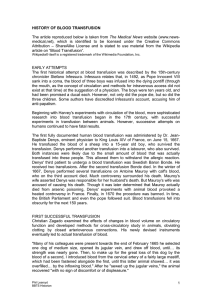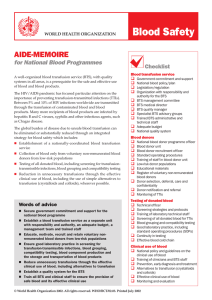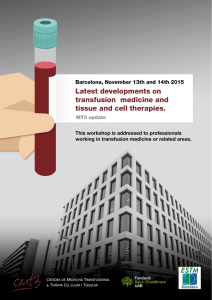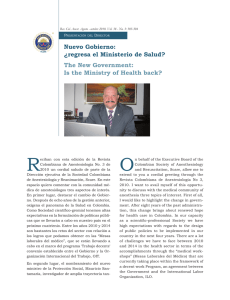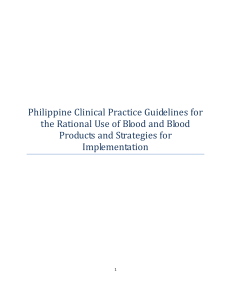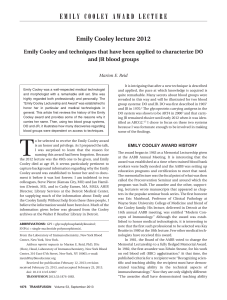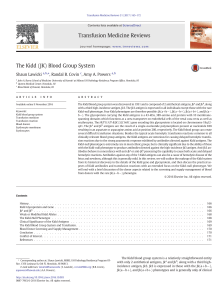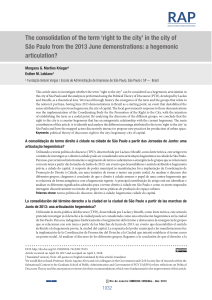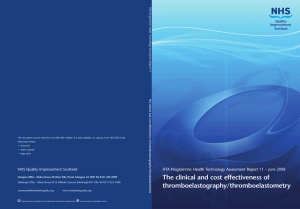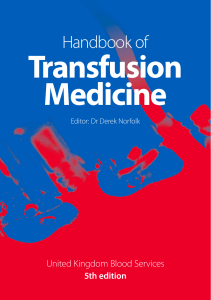A comprehensive protocol to evaluate the use of blood
Anuncio
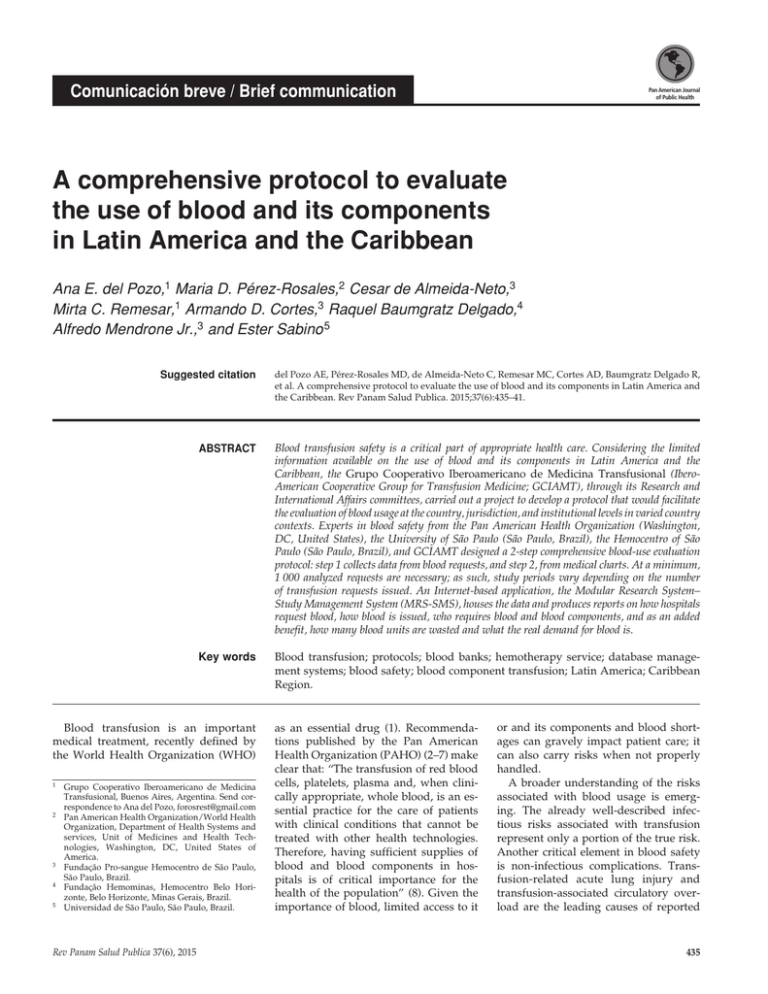
Comunicación breve / Brief communication Pan American Journal of Public Health A comprehensive protocol to evaluate the use of blood and its components in Latin America and the Caribbean Ana E. del Pozo,1 Maria D. Pérez-Rosales,2 Cesar de Almeida-Neto,3 Mirta C. Remesar,1 Armando D. Cortes,3 Raquel Baumgratz Delgado,4 Alfredo Mendrone Jr.,3 and Ester Sabino 5 Suggested citation del Pozo AE, Pérez-Rosales MD, de Almeida-Neto C, Remesar MC, Cortes AD, Baumgratz Delgado R, et al. A comprehensive protocol to evaluate the use of blood and its components in Latin America and the Caribbean. Rev Panam Salud Publica. 2015;37(6):435–41. abstract Blood transfusion safety is a critical part of appropriate health care. Considering the limited information available on the use of blood and its components in Latin America and the Caribbean, the Grupo Cooperativo Iberoamericano de Medicina Transfusional (IberoAmerican Cooperative Group for Transfusion Medicine; GCIAMT), through its Research and International Affairs committees, carried out a project to develop a protocol that would facilitate the evaluation of blood usage at the country, jurisdiction, and institutional levels in varied country contexts. Experts in blood safety from the Pan American Health Organization (Washington, DC, United States), the University of São Paulo (São Paulo, Brazil), the Hemocentro of São Paulo (São Paulo, Brazil), and GCIAMT designed a 2-step comprehensive blood-use evaluation protocol: step 1 collects data from blood requests, and step 2, from medical charts. At a minimum, 1 000 analyzed requests are necessary; as such, study periods vary depending on the number of transfusion requests issued. An Internet-based application, the Modular Research System– Study Management System (MRS-SMS), houses the data and produces reports on how hospitals request blood, how blood is issued, who requires blood and blood components, and as an added benefit, how many blood units are wasted and what the real demand for blood is. Key words Blood transfusion; protocols; blood banks; hemotherapy service; database management systems; blood safety; blood component transfusion; Latin America; Caribbean Region. Blood transfusion is an important medical treatment, recently defined by the World Health Organization (WHO) 1 Grupo Cooperativo Iberoamericano de Medicina Transfusional, Buenos Aires, Argentina. Send correspondence to Ana del Pozo, [email protected] 2 Pan American Health Organization/World Health Organization, Department of Health Systems and services, Unit of Medicines and Health Technologies, Washington, DC, United States of America. 3 Fundação Pro-sangue Hemocentro de São Paulo, São Paulo, Brazil. 4 Fundação Hemominas, Hemocentro Belo Horizonte, Belo Horizonte, Minas Gerais, Brazil. 5 Universidad de São Paulo, São Paulo, Brazil. Rev Panam Salud Publica 37(6), 2015 as an essential drug (1). Recommendations published by the Pan American Health Organization (PAHO) (2–7) make clear that: “The transfusion of red blood cells, platelets, plasma and, when clinically appropriate, whole blood, is an essential practice for the care of patients with clinical conditions that cannot be treated with other health technologies. Therefore, having sufficient supplies of blood and blood components in hospitals is of critical importance for the health of the population” (8). Given the importance of blood, limited access to it or and its components and blood shortages can gravely impact patient care; it can also carry risks when not properly handled. A broader understanding of the risks associated with blood usage is emerging. The already well-described infectious risks associated with transfusion represent only a portion of the true risk. Another critical element in blood safety is non-infectious complications. Transfusion-related acute lung injury and transfusion-associated circulatory overload are the leading causes of reported 435 Brief communication transfusion-related deaths. Furthermore, case-controlled studies of medical, surgical, and intensive care unit cohorts suggest an association between unnecessary transfusion and poorer patient outcomes (9–12). Several studies have shown that more restrictive strategies for transfusing packed red blood cells in critical patients are at least as effective, and probably better than, liberal strategies (13–15). The implementation of a national/hospital patient blood transfusion management system/program can lead to better outcomes as well (13–15). Therefore, in addition to addressing insufficiencies in the blood supply, there is a need to review and hone transfusion practices. However, there are very few clinical trials evaluating how blood should be used. The use of blood transfusion therapies may vary according to medical practice traditions within and between countries and over time, particularly as blood availability, component therapy, and transfusion management practices fluctuate or change. Literature that investigates how blood is being used is especially scarce in developing countries (16–18). Collection of such data may improve the understanding of fluctuations in demand and help to predict future trends. It may also allow for the detection of major blood misusage and whether or not blood centers are able to fulfill hospital requests. The few, available studies on blood usage used different approaches. For instance, a study by Vamvakas and colleagues (19) collected data using a series of questions for experts in the field of transfusion epidemiology in Australia, Denmark, the United Kingdom, and the United States; and another, by Chiavetta and colleagues (20), analyzed discharge records from approximately 500 000 hospitalized patients. The latter (20) provides blood transfusion information that “can help to determine the need for hospital audits and maximum surgical bloodorder schedule guideline reviews.” These authors state that this information is relevant to reducing patient’s exposure to blood components. Wells and colleagues prospectively collected data from several transfusion centers to better understand blood usage, specifically where the blood was sent and who received it (21, 22). Later, Llewelyn and colleagues (23) analyzed large data sets from representative hospitals in England and Wales using a new approach to determine the reasons 436 del Pozo et al. • Protocol for evaluating blood usage for transfusion. All the studies used a short questionnaire that was completed by the blood bank when dispensing each transfusion unit. In 2012, Gonzales and colleagues, following a similar approach, retrospectively analyzed the database from a single tertiary care hospital in Brazil (17). Acknowledging gaps in the understanding of blood usage and its critical impact on patient outcomes, in 2014, the Pan American Health Organization summarized the situation in its “Plan of Action for Universal Access to Safe Blood” as follows: Concerning the rational use of blood and blood products, 20 of the 41 countries and territories in Latin America and the Caribbean reported having guidelines for the clinical use of blood, while only seven have transfusion committees in 75% of hospitals at the national level. From the information available in the countries, it is not possible to characterize blood recipients by age, sex, and pathology or determine the epidemiological factors that affect needs or the estimated number of units transfused by event (24). Considering the limited information available on the use of blood and its components in Latin America and the Caribbean, the Grupo Cooperativo Iberoamericano de Medicina Transfusional (Ibero-American Cooperative Group for Transfusion Medicine; GCIAMT), through its Research and International Affairs committees, undertook the development of a blood-use study protocol that would facilitate the evaluation of blood use in the different contexts that comprise the Region and at the country, jurisdiction, and institutional levels. Experts in blood safety from PAHO, the University of São Paulo (São Paulo, Brazil), and the Hemocentro of São Paulo (São Paulo, Brazil) initially met in São Paulo, Brazil, in May 2014, to determine the study design, and continued its work online until completion in October 2014. The Expert Working Group analyzed the available information and developed a model platform and an Internet-based system that serves as a uniform set of tools to assist countries, jurisdictions, and institutions in collecting and using data on blood and blood components use. This brief communication summarizes the results of this effort, explains the protocol itself, and makes available the tools necessary for evaluating blood usage. The protocol and database tool produces reports that quantify the use of blood and its components, identify shortages and waste, and ultimately, produce better patient outcomes. Study design and methods This protocol will guide the users to perform a descriptive, cross-sectional survey to evaluate the use of blood among countries/jurisdictions/institutions in Latin America and Caribbean. Two types of questionnaires constitute a 2-step process of data collection: Questionnaire 1 collects information from blood requests, including: a description of the hospital making the request (public/private, number of beds, existence of transfusion committee, etc.); description of the patient receiving the transfusion (age, gender, diagnosis, etc.); type of transfusion request (degree of urgency; reason for transfusion; number of platelet units, volume of red blood cells, and/or volume of plasma requested); and the clinical area making the request (e.g., neonatology, obstetrics, etc.). For the complete questionnaire, see Annex 1, Questionnaire 1. Questionnaire 2 collects information from the medical chart of the blood recipient, including: type and number of units that were effectively transfused; reason for transfusion, registered according to a comprehensive list; and additional details on red blood cells, platelets, and plasma, such as patient diagnosis. For the complete questionnaire, see Annex 1, Questionnaire 2. Participating hospitals and blood service providers For a representative sample of transfusion requests in a given country, jurisdiction, and/or institution, hospitals should be listed according to the number of annual transfusion requests, from greatest to least, and the ones accounting for 80% of the demand should be preferentially included in the study. Sample size Being a descriptive study, as long as the majority of the leading transfusion centers are included, 1 000 questionnaires should provide enough power to describe the main reasons for blood usage. Rev Panam Salud Publica 37(6), 2015 del Pozo et al. • Protocol for evaluating blood usage For a country, jurisdiction, and/or institution that makes more than 15 000 blood requests annually, 30 days of data collection are sufficient for the study. For those with less than 15 000 annual requests, a longer period may be necessary. Therefore, the first task is to determine how many transfusion requests each participating hospital/service makes in a 30-day period. If more than 1 000, Questionnaire 1 will be applied to all requests, but only a proportion will be randomly-selected for Questionnaire 2 (since this data is harder to obtain). For Questionnaire 2, only a total of 1 000 is recommended. For example, if a jurisdiction has 10 000 blood requests per month, all should be processed using Questionnaire 1, but only 10% should be randomly-selected for Questionnaire 2. Brief communication FIGURE 1. The Modular Research System–Study Management System: example of list of patients/recipients of blood or blood components and links to Questionnaires 1 and 2 Data collection period After defining the total study period necessary (more than 30 days for those with fewer than 15 000 requests per year), the participant(s) should choose two 15-day periods, with a minimum interval of 30 days between them. Periods of known blood shortage should be avoided. Each day, Questionnaire 1 should be completed for all requests made during the previous 24 hours. Every other day, 10% of the requests should be randomly-selected for Questionnaire 2, which is based on medical records. A nurse or physician should review the medical chart of those patients. FIGURE 2. The Modular Research System–Study Management System: example of possible blood and blood component usage reports Data collection tools To facilitate auditing of the data collection, an Internet-based tool, the Modular Research System–Study Management System (MRS-SMS), was developed to manage the study procedures and make available all the items on Questionnaires 1 and 2. The system will randomly select the requests for Questionnaire 2. It does this by assigning a random number from 0 to 1 to each unit included. If a site delivers 10 000 units per month, 10% of the units need to be processed using Questionnaire 2. MRS-SMS is a password-protected Internet system that registered users access at: http://modularresearchsystem. com.br/useofbloodinla/. Figures 1 and 2 show some features of the system. All data entered in MRS-SMS may be extracted at any time, by exporting the data Rev Panam Salud Publica 37(6), 2015 437 Brief communication to a comma-separated-variables (CSV) extension file that can be exported to most statistical software programs for analysis. Each country/jurisdiction/institution should designate certain staff to collect and analyze the data. The investigator at each site will create user names and passwords. Users will not be able to see or extract data from any site other than their own. Data from other sites can only be accessed with the permission of its principle investigator. Data analysis A descriptive data analysis should consist of frequency distributions of the main variables. The number and type of units transfused should be stratified by gender, age, and medical condition of the patients. DISCUSSION There can be many challenges with developing a study protocol such as this one. First, the study will need to consider differing countries, jurisdictions, and/or del Pozo et al. • Protocol for evaluating blood usage institutions throughout Latin American and Caribbean and variations in blood request procedures among diverse institutions and medical specialties. Second, random-selection of hospitals may not be achievable because some of them may not be willing to participate. Third, the use of blood may differ during the year. Elective surgery, for example, is less common during long holidays, and if there is a blood shortage, may be postponed. Lastly, some hospitals may lack information systems or have only partial records, or the patient’s medical records and transfusion requests may be incomplete. The working group strove to address all these challenges by designing a unique protocol to be used in a large geographic area with a wide range of country contexts. This communication presents this protocol and its tools as a platform for streamlining a study of blood usage, from how requests are made to how transfusions are used, in almost any context. Moreover, such studies will improve the overall information systems in hospitals, and point to areas requiring additional research. Evalua- tion of variables related to transfusion management, documentation of the process, current blood needs, and wasted blood units will elucidate areas for further analysis and actions. Studies that follow this protocol and use the tools will discover any need for patient-blood management programs at the country, jurisdictional, or hospital levels, and weaknesses in the hemo­ vigilance programs, among others. Lastly, studies of this nature align with the recommendations and accomplish all of the activities outlined in the “Plan of Action for Universal Access to Safe Blood” (24), approved by PAHO at its recent Directing Council meeting. Acknowledgments. The authors wish to thank Ligia Capuani and Helves Domingues for developing of the Modular Research System–Study Management System (MRS-SMS), and Graciela León of the Grupo Cooperativo Iberoamericano de Medicina Transfusional (Buenos Aires, Argentina) for revising the manuscript. Conflicts of interest. None. REFERENCES 1. Klein HG. Should blood be an essential medicine? New England J Med. 2013;368(3):199–201. 2.Spiess BD. Red cell transfusions and guidelines: a work in progress. Hematol Oncol Clin North America. 2007;21(1):185–200. 3.Liumbruno G, Bennardello F, Lattanzio A, Piccoli P, Rossetti G, for the Italian Society of Transfusion Medicine and Immunohaematology Working Party. Recommendations for the transfusion of plasma and platelets. Blood Transfus. 2009;7(2):132–50. 4. Spinella PC. Warm fresh whole blood transfusion for severe hemorrhage: U.S. military and potential civilian applications. Crit Care Med. 2008;36(7 Suppl):S340–5. 5. Boucher BA, Hannon TJ. Blood management: a primer for clinicians. Pharmacotherapy. 2007;27(10):1394–411. 6.Marwaha N, Sharma RR. Consensus and controversies in platelet transfusion. Transfus Apher Science. 2009;41(2):127–33. 7.Morley SL. Red blood cell transfusions in acute paediatrics. Arch Dis Child Educ Pract Ed. 2009;94(3):65–73. 8. Pan American Health Organization. Recommendations for estimating the need for blood and blood components. Washington, DC: PAHO; 2010. Available from: www2.paho.org/hq/dm documents/2010/RecommendationEN(web). pdf Accessed on 10 March 2015. 9.Kao DP, Kreso E, Fonarow GC, Krantz MJ. Characteristics and outcomes among heart 438 failure patients with anemia and renal insufficiency with and without blood transfusions (public discharge data from California 2000–2006). Am J Cardiol. 2011;107(1):69–73. 10.Khorana AA, Francis CW, Blumberg N, ­Culakova E, Refaai MA, Lyman GH. Blood transfusions, thrombosis, and mortality in hospitalized patients with cancer. Arch Intern Med. 2008;168(21):2377–81. 11. Marik PE, Corwin HL. Efficacy of red blood cell transfusion in the critically ill: a systematic review of the literature. Crit Care Med. 2008;36(9):2667–74. 12. Ranucci M, Aronson S, Dietrich W, Dyke CM, Hofmann A, Karkouti K, et al. Patient blood management during cardiac surgery: do we have enough evidence for clinical practice? J Thorac Cardiovasc Surg. 2011;147(5):249. 13.Leal-Noval SR, Arellano-Orden V, MaestreRomero A, Muñoz-Gómez M, FernándezCisneros V, Ferrándiz-Millón C, et al. Impact of national transfusion indicators on appropriate blood usage in critically ill patients. Transfusion. 2011;51(9):1957–65. 14. Menitove JE, Leach Bennett J, Tomasulo P, Katz LM. How safe is safe enough, who decides and how? From a zero-risk paradigm to a risk-based decision making. Transfusion. 2014;54 (3):753–7. 15.Friedman MT, Avadhani V, Gilmore S, Madrigal E. Blood transfusion in the 21st ­ century. Discoveries. 2014;2(1):e11 Avail- able from: http://discoveriesjournals. org/D.2014.01.RA-Dr%20Friedman.pdf Accessed on 5 May 2015. 16. Cortés A, Beltrán M, Olaya B, Hernández M. Epidemiología de la colección, proceso y uso de sangre y componentes sanguíneos en el Valle del Cauca, Colombia. Colombia Med. 1999;30:5–12. 17.Pugliese AM, Diez RS, Magaldi BG, del Pozo AE. Estimación de las necesidades de componentes de la sangre de un hospital pediátrico de alta complejidad. Rev Arg Transfusión. 2011;37(3):174. Available from: www.aahi.org.ar/wp content/ uploads/2014/06/RAT201103.pdf Accessed on 5 May 2015. 18.Goncalez TT, Sabino EC, Capuani L, Liu J, Wright DJ, Walsh JH, Ferreira JE, et al. The NHLBI Retrovirus Epidemiology Donor Study-II (REDS-II): International component blood transfusion utilization and recipient survival at Hospital das Clinicas in São Paulo, Brazil. Transfusion. 2012;52(4):729–38. 19.Vamvakas EC, Taswell HF. Epidemiology of blood transfusion. Transfusion. 1994;34 (6):464–70. 20. Chiavetta JA, Herst R, Freedman J, Axcell TJ, Wall AJ, van Rooy SC. A survey of red cell use in 45 hospitals in central Ontario, Canada. Transfusion. 1996;36 (8):699–706. 21. Wells AW, Mounter PJ, Chapman CE, Stainsby D, Wallis JP. Where does blood go? Rev Panam Salud Publica 37(6), 2015 del Pozo et al. • Protocol for evaluating blood usage Prospective observational study of red cell transfusion in North England. BMJ. 2002; 325(7368):803. 22.Wells AW. Who uses blood? Vox Sang. 2004;87(suppl 2):146–8. 23.Llewelyn CA, Wells AW, Amin M, Casbard A, Johnson AJ, Ballard S, et al. The EASTR study: a new approach to determine the rea- sons for transfusion in epidemiological studies. Transfus Med. 2009;19(2):89–98. 24.Pan American Health Organization. The PAHO/WHO plan of action for universal access to safe blood. Washington, DC: PAHO; 2014. [Document CD53/6]. Available from: www.paho.org/hq/index.php?option=com_ content&view=article&id=9774:53rd-direct- Brief communication ing-council&Itemid=41062&lang=en#officia Accessed on 10 March 2015. Manuscript received on 18 December 2014. Revised version accepted for publication on 24 March 2015. ANNEX 1 Questionnaire 1 Part 1. Hospital information 1.1. Hospital ID: ____________________________________________________ 1.2. Hospital profile: 1.2.1. Type of assistance: ( ) public ( ) private (Note: both may be checked) 1.2.2 Number of beds: ( ) <50 ( ) ≥ 50–100 ( ) ≥ 100–500 ( ) ≥ 500 1.2.3. Is there a transfusion unit/hemotherapy service in the hospital? ( ) Yes ( ) No 1.2.4. Is there a transfusion committee in the hospital? ( ) Yes ( ) No 1.2.5. Are there transfusion guidelines in the hospital? ( ) Yes ( ) No Part 2. Recipient information 2.1. Patient ID: ____________________________________________ 2.2. Patient profile: 2.2.1. ( ) Inpatient ( ) Outpatient 2.2.2. Date of birth: ___ / ___/ ___ (day/month/year) 2.2.3. Gender: ( ) Male ( ) Female 2.2.4. Weight: _______ (in Kilograms) 2.3. Blood request information: 2.3.1. Is there blood count in the request? ( ) Yes ( ) No 2.3.1.1. If yes: Hb___g/dL Hct___% for red blood cells 2.3.1.2. If yes: Platelets _________/mm3 for platelets concentrates 2.3.2. Prothrombin or thromboplastin time? ( ) Yes ( ) No 2.4. Diagnostic: _______________________________(open field) 2.4.1. Principal diagnosis (for example, brain tumor) ______________________ 2.4.2. Diagnosis for transfusion (hemorrhage and anemia) __________________ 2.4.3. International Classification of Disease, 10th edition (ICD-10) code:_____ 2.4.4. Previous transfusions? ( ) Yes ( ) No 2.4.4.1. If yes, date of the last transfusion: ___ / ___/ ___ (day/month/year) Part 3. Transfusion request 3.1. Date: ___ / ___/ ___ (day/month/year) 3.2. Type of request: 3.2.1. ( ) extreme urgency, without cross-match 3.2.2. ( ) urgency (within 3 hours) 3.2.3. ( ) routine (within 24 hours) 3.2.4. ( ) scheduled (more than 24 hours ) 3.2.5. ( ) reservation 3.3. Transfusion prescription _________________(open field) 3.4. How many units were requested? 3.4.1. Random platelets ______ units/pool or apheresis ____units 3.4.2. Red cell ____ units leukodepleted? ( ) Yes ( ) No 3.4.3. Plasma _____ units 3.5. How many units were transfused? 3.5.1. Random platelets ______ units/pool or apheresis ____units 3.5.2. Red cell _____ units leukodepleted? ( ) Yes ( ) No 3.5.3. Plasma _____ units 3.6. How many units were timely returned, allowing for its use in any other patient? 3.6.1. Random platelets ______ units/pool or apheresis____units 3.6.2. Red cell _____ units leukodepleted? ( ) Yes ( ) No 3.6.3. Plasma _____ units 3.7. Classify the clinical area that requested the transfusion: _______ 3.7.1. ( ) Neonates 3.7.2. ( ) Emergency room 3.7.3. ( ) Obstetrics and Gynecology 3.7.3.1. ( ) Obstetrics 3.7.3.2. ( ) Gynecology Rev Panam Salud Publica 37(6), 2015 439 Brief communication 3.7.4. 3.7.5. del Pozo et al. • Protocol for evaluating blood usage Medical clinical (adults and children–except neonate) 3.7.4.1. ( ) Oncology 3.7.4.2. ( ) Non-oncology/hematology 3.7.4.3. ( ) Bone marrow/hematopoietic progenitor cell transplantation 3.7.4.4. ( ) Gastroenterology 3.7.4.5. ( ) Intensive Care Unit 3.7.4.6. ( ) General clinic–others (pneumonology, cardiology, etc.) ( ) Surgery (adults and children–except neonate) 3.7.5.1. ( ) Orthopedic 3.7.5.2. ( ) Cardiac 3.7.5.3. ( ) Vascular 3.7.5.4. ( ) Gastrointestinal 3.7.5.5. ( ) Others. Specify:________________________________ Questionnaire 2 1. How many units were effectively transfused? 1.1. Random platelets ______ units/pool or apheresis ____units 1.2. Red cell _____ units leukodepleted? ( ) Yes ( ) No 1.3. Plasma _____ units 2. If not transfused, describe the reason: 2.1. ( ) Not provided/Blood product was not available 2.2. ( ) Patient refusal 2.3. ( ) Patient died 2.4. ( ) Changes in the clinical conditions 2.5. ( ) Others. Specify:___________________________ 3.What is the patient main disease according to the International Classification of Diseases, 10th edition (ICD-10)? ______________________ 3.1. ICD-10 code: ___________ 4. Which was the cause for transfusion indication? 5.Specify the proper sub-item for each blood component and the indications according to items 5.1 for red blood cell, 5.2 for platelets, and 5.3 for plasma: Red blood cell–sub-item: ___________ Platelets–sub-item: _________________ Plasma–sub-item:_________________________ 5.1. Red blood cells: 5.1.1. Hematology/oncology 5.1.1.1. ( ) Anemia associated to deficiencies of: iron, folate, and vitamin B-12, and others. 5.1.1.2. ( ) Anemia associated to acute blood loss (Gastrointestinal [lower/upper], politrauma, hemostatic disorders, and others) 5.1.1.3. ( ) Anemia associated with chronic diseases (including renal diseases and liver diseases) 5.1.1.4. ( ) Hemolytic anemia (acquired, including malaria; and hereditary hemolytic anemia) 5.1.1.5. ( ) Anemias associated with sepsis 5.1.1.6. ( ) Hyperbilirrubinemia in neonates 5.1.1.7. ( ) Aplastic anemia 5.1.1.8. ( ) Leukemia (acute or chronic) 5.1.1.9. ( ) Lymphomas 5.1.1.10. ( ) Multiple myeloma 5.1.1.11. ( ) Mielodysplastic syndromes 5.1.1.12. ( ) Solid tumors (under chemotherapy or without chemotherapy) 5.1.1.13. ( ) Hematopoietic cell transplantation 5.1.1.14. ( ) Others (specify) ____________________________ 5.1.2. ( ) Surgery: 5.1.2.1. Orthopedics: 5.1.2.1.1. ( ) Total hip replacement 5.1.2.1.2. ( ) Total knee replacement 5.1.2.1.3. ( ) Spinal pathology 5.1.2.1.4. ( ) Congenital luxation 5.1.2.1.5. ( ) Fracture of the femur 5.1.2.1.6. ( ) Politrauma 5.1.2.1.7. ( ) Others (specify)__________________________ 5.1.3. Cardiovascular surgery: 5.1.3.1.1. ( ) Coronary by-pass 5.1.3.1.2. ( ) Valve replacement 5.1.3.1.3. ( ) Aneurysm repair 5.1.3.1.4. ( ) Others (specify) ___________________________ 440 Rev Panam Salud Publica 37(6), 2015 del Pozo et al. • Protocol for evaluating blood usage Brief communication 5.1.4. ( ) Abdominal and colorectal surgery 5.1.5. ( ) Neurosurgeries (trauma, tumors, congenital malformations, among others) 5.1.6. ( ) Urologic surgeries (all, including tumors) 5.1.7. ( ) Otorhynolaryngologic surgery (fibro-angiomas, craneofacial tumor, craneofacial malformations, others) 5.1.8. ( ) Solid organ transplants (heart, lung, renal, liver, others) 5.1.9. ( ) Plastic surgery (craneofacial malformations, severe burns, aesthetic surgery) 5.2.Platelets: 5.2.1. ( ) Prophylactic to prevent bleeding 5.2.1.1. ( ) Routine use in non-bleeding patient (including neonates) 5.2.1.2. ( ) Pre-procedure to prevent bleeding (surgery/invasive procedure) 5.2.2. ( ) Therapeutic to treat active bleeding 5.2.3. Causes 5.2.3.1. ( ) Reversible bone marrow failure (associated with treatable disease and/or chemotherapy) 5.2.3.2. ( ) Chronic (irreversible) bone marrow failure, e.g., myelodysplastic syndromes 5.2.3.3. ( ) P eripheral platelet destruction/consumption, e.g., immune thrombocytopenia and disseminated intravascular coagulation 5.2.3.4. ( ) A bnormal platelet function inherited or acquired disorders, e.g., anti-platelet agents, heparin, other drugs, and uremic patients 5.2.3.5. ( ) Others (specify)_________________________________ 5.3.Plasma: 5.3.1. ( ) Did the patient have active bleeding at the time of blood request? ( ) Yes ( ) No 5.3.2. What is the clinical condition? ________ 5.3.2.1. ( ) Single coagulation factor deficiencies 5.3.2.2. ( ) Multiple coagulation factor deficiencies 5.3.2.3. ( ) Disseminated intravascular coagulation 5.3.2.4. ( ) Thrombotic thrombocytopenic purpura 5.3.2.5. ( ) Reversal of warfarin effect 5.3.2.6. ( ) Vitamin K deficiency in the intensive care unit 5.3.2.7. ( ) Liver disease 5.3.2.8. ( ) Surgical bleeding and massive transfusion 5.3.2.9. ( ) Bleeding due to hemorrhagic disease of the newborn resumen Un protocolo integral para evaluar el uso de la sangre y sus componentes en América Latina y el Caribe Palabras clave Rev Panam Salud Publica 37(6), 2015 La seguridad de las transfusiones de sangre constituye una parte fundamental de una apropiada atención de salud. Teniendo en cuenta la limitada información disponible sobre el uso de la sangre y sus componentes en América Latina y el Caribe, el Grupo Cooperativo Iberoamericano de Medicina Transfusional (GCIAMT), mediante sus comités de Investigación y de Asuntos Internacionales, llevó a cabo un proyecto de elaboración de un protocolo que facilitara la evaluación del uso de la sangre a nivel de país, jurisdiccional e institucional, en diversos contextos de país. Expertos en seguridad de la sangre de la Organización Panamericana de la Salud (Washington, DC, Estados Unidos), la Universidad de São Paulo (São Paulo, Brasil), el Hemocentro de São Paulo (São Paulo, Brasil) y el GCIAMT diseñaron un protocolo integral de evaluación del uso de la sangre en 2 etapas: en la primera se recopilan datos de las solicitudes de sangre, y en la segunda, de las historias clínicas. Como mínimo, es preciso analizar 1 000 solicitudes; por ello, los períodos de estudio varían en dependencia del número de solicitudes de transfusión expedidas. Una aplicación basada en internet, el Modular Research System, Study Management System, alberga los datos y elabora informes sobre cómo solicitan sangre los hospitales, cómo se expide la sangre, quién requiere sangre y componentes sanguíneos y, como beneficio añadido, cuántas unidades de sangre se desperdician y cuál es la demanda real de sangre. Transfusión sanguínea; protocolos; bancos de sangre; servicio de hemoterapia; sistemas de administración de bases de datos; seguridad de la sangre; transfusión de componentes sanguíneos; América Latina; Región del Caribe. 441
